How To Correct A Drawings Coordinate System In Maps 3d
Projections are calculations that allow you to draw the round globe on a flat screen or piece of paper. If y'all've fabricated a map before, yous've used a projection.
Every map deforms the earth. Information technology is impossible to represent a curved surface (the earth) on a flat i (a map) without stretching, skewing, and tearing it. Map projections apply this distortion in a systematic way that allows you to control where and how it happens. This lesson volition introduce you lot to tools and techniques to assistance you choose the correct projection for your map.
This lesson was last tested on November 11, 2022, using ArcGIS Pro 2.nine. If you're using a dissimilar version of ArcGIS Pro, you may encounter different functionality and results.
Lesson Program
Sympathize projectionsLearn how dissimilar projections misconstrue the earth in unlike ways. |
|
Map global analysis resultsSearch for an equal expanse project. |
|
Map polar dataApply, test, and change an equidistant project. |
|
Map the border of two UTM zonesBuild a custom projected coordinate organisation from suggested parameters. |
|
Sympathize projections
You will non observe a projection that is suitable for all maps. All projections distort the earth in some way. Each one seeks to preserve some geometric property at the expense of others.
Projection types
Conformal projections preserve angles locally, so the shapes of features appear true. But the cost of this quality is the baloney of areas and distances. Equal area projections preserve area, at the expense of angles, so the shapes of some places appear skewed. Equidistant projections preserve distances, although only from certain points or along certain lines on the map.

Compromise projections provide a representation of the globe that is not perfectly correct in any way but not desperately distorted in any mode either. They are usually used for maps of the entire world.
There are dozens of projections available in ArcGIS that can exist configured into endless projected coordinate systems. Your pick of a projected coordinate system depends on many factors, including the part of the world you are mapping, the scale of your map, and the purpose of your map. You desire to choose a projected coordinate system in which the places and properties that are near of import to your map are the least distorted.
Map global analysis results
Map projections distort the grid of latitude and longitude lines, which means they also distort your information. Yous've taken slap-up care to conduct an analysis of future precipitation changes properly and precisely. Adjacent, you need to nowadays your results on a map. You want to choose a project that will allow you to nowadays those results clearly, so they are not misinterpreted.
Find a global equal area projection
First, you'll explore a few traditional resources to help you lot detect a suitable projection for your analysis results.
- Download the Projections projection package.
- Locate the downloaded Projections.ppkx file on your computer. Double-click the file to open information technology in ArcGIS Pro. If prompted, sign in to your ArcGIS Online or ArcGIS Enterprise business relationship.
If you don't accept ArcGIS Pro or an ArcGIS account, y'all tin sign upwardly for an ArcGIS free trial.
The project has 3 maps. The Precipitation Change map is active.
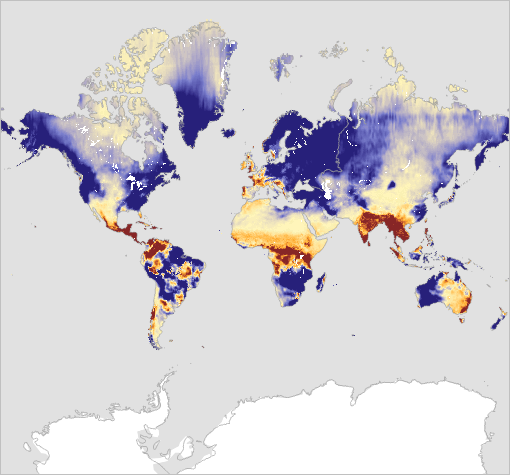
The data on this map shows predicted precipitation anomalies for the years 2040 to 2059. The green areas are predicted to accept more atmospheric precipitation in the future compared to celebrated averages. The brown areas are predicted to experience less.
Commencement, you'll find out which project this map is using.
- In the Contents pane, right-click Atmospheric precipitation Change and cull Backdrop.
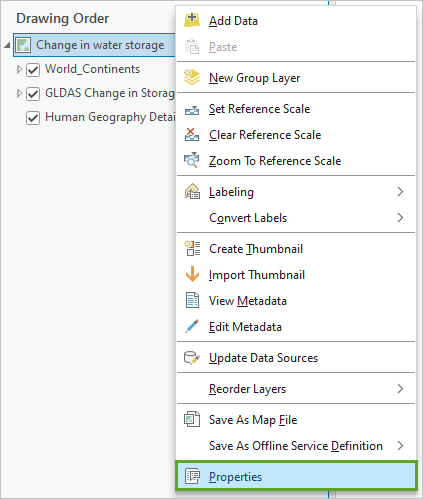
- In the Map Properties window, click the Coordinate Systems tab.
Nether Current XY, you tin encounter that the electric current coordinate arrangement for this map is WGS 1984 Web Mercator (auxiliary sphere).
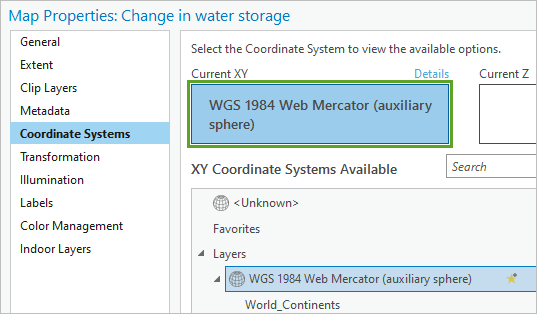
Spider web Mercator is a mutual projected coordinate organisation designed for web mapping applications. Nearly of Esri's basemaps are tiled in Web Mercator, so they can have the greatest compatibility. Even so, this projection does not preserve areas, distances, or angles.
- In the Map Properties window, click Cancel.
Looking at this map, you may recollect that Greenland is many times larger than India. In fact, Greenland is slightly smaller than India. If the Web Mercator project distorts the relative sizes of countries and then dramatically, you know that information technology must also exist distorting your assay results.
This map suggests that the areas that will experience the about extreme change in precipitation are a relatively pocket-size portion of the earth, just a narrow band along the equator. Web Mercator is not an appropriate choice for this map. Next, you'll consult a nautical chart that compares projections to notice one that is appropriate for your map.
- Open up Quick Notes on Map Projections in ArcGIS.
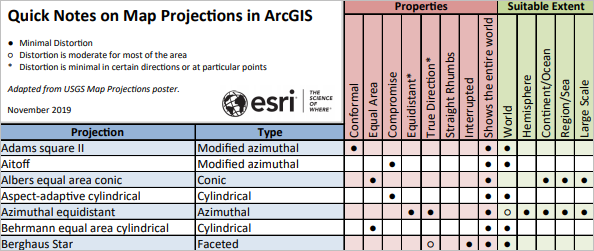
The belongings that is most important to preserve in your precipitation map is area. This is truthful for nigh maps presenting analysis results involving expanse, density, or altitude comparisons.
- Use the chart to find a projection that meets the following criteria:
- Backdrop: Equal Surface area
- Suitable Extent: World
- General Purpose: Thematic
There are a few projections that are suitable for your map. One of them is Equal World.
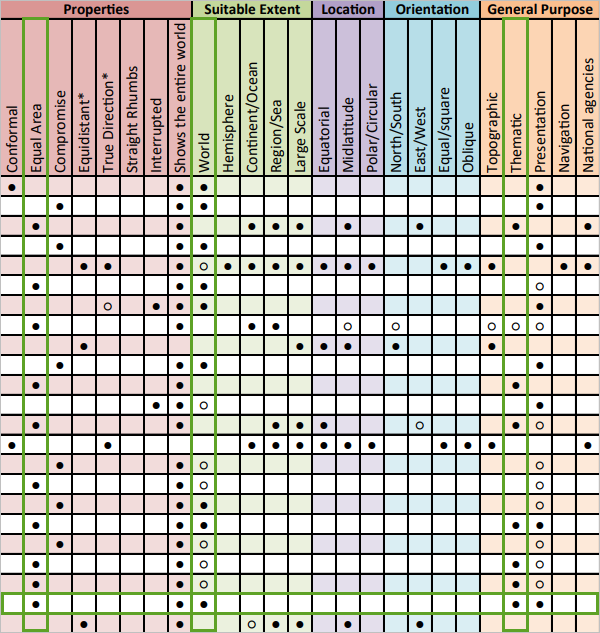
- Become to the ArcGIS Pro help page for the Equal Earth projection. Roll down and read the Usage section.
You tin can read about whatever projection plant in ArcGIS to help you decide which is best for your map.
Change the map's projected coordinate organization
You've decided to use the Equal Earth project. Adjacent, you'll apply it to your Precipitation Change map.
- In ArcGIS Pro, in the Contents pane, double-click Precipitation Change to open the Map Properties window.
- Click the Coordinate Systems tab.
- In the search bar, type Equal Earth and press Enter.
The list of bachelor coordinate systems filters based on your search.
- Expand Projected Coordinate System and expand World. Click Equal Globe (globe).
The Current XY push button updates to indicate that the map's coordinate arrangement has changed.
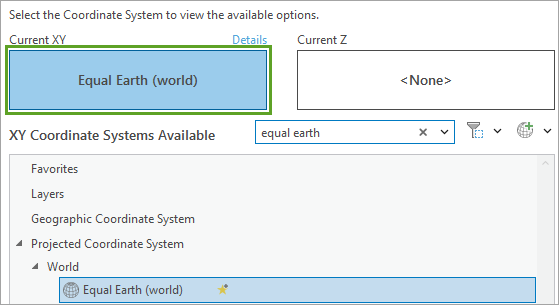
Tip:
Changing the coordinate organisation in the Map Properties window affects only the map. It does not change the coordinate system of your data layers. The layers are projected on the fly to depict correctly on the map. To larn more about projection on the fly, read this blog article.
- In the Map Backdrop window, click OK.
The new projected coordinate organisation is practical to your map.
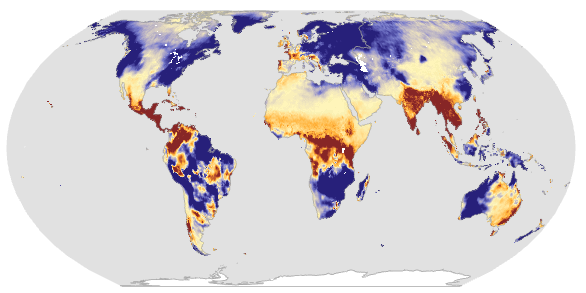
The assay results are at present presented in a form that preserves relative areas, so your map readers tin accurately compare the sizes of precipitation anomalies.
- On the Quick Access Toolbar, click Salve to save the project.
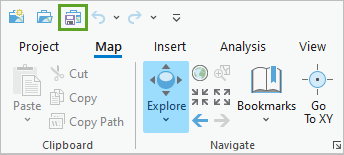
Beneath is a comparing of the two projections at the same scale. How might the Web Mercator project mislead or hinder people from properly interpreting your assay results?
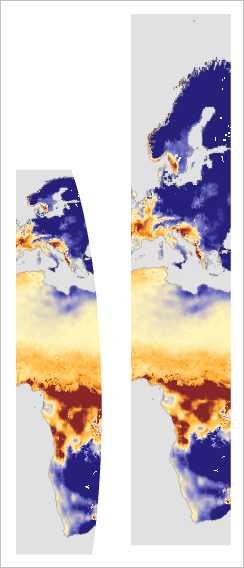
The Equal Globe projection is designed to show the entire world, but there are two parts of the world that it is unable to map finer. Next, you'll try a projection designed to map polar regions.
Map polar information
A compass needle does not indicate to the true north pole. Instead, it points to the magnetic north pole, a location that is constantly changing. Next, you'll make a map to show the wandering path the magnetic pole has taken over the past 400 years. You also want to use this map to show whether the magnetic north pole is moving closer to, or further away from, truthful due north.
Find a polar equidistant project
You'll search for a projected coordinate system that preserves distances from the north pole.
- At the pinnacle of the map view, click the Due north Pole tab to activate that map.
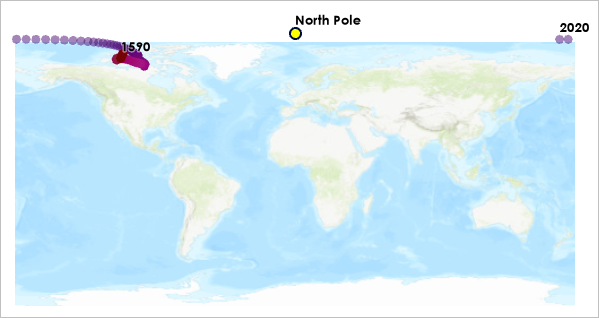
The information in this map was provided by NOAA National Centers for Environmental Information (NCEI).
The map does a poor job of illustrating the changing location of the magnetic north pole. The points all appear to be far away from the true northward pole, and they are also dissever upwards on either side of the map. Measurements made on this map would exist meaningless.
For this map's projection, you accept 2 criteria:
- To display the chill data more than naturally, you need a projection designed for polar regions.
- To determine how close magnetic n is to true due north, you demand an equidistant project, which volition preserve accurate distance measurements to the due north pole.
Next, you'll find an advisable projected coordinate system past searching for keywords.
- In the Contents pane, double-click Northward Pole to open the Map Properties window.
This map currently uses a geographic coordinate system, WGS 1984. When a geographic coordinate system is selected, your map will be projected using the pseudo-plate carrée projection. You tin read more than about the departure between geographic and projected coordinate systems in this blog article.
- On the Coordinate Systems tab, search for Equidistant.
- Expand the Projected Coordinate System list and aggrandize Polar.
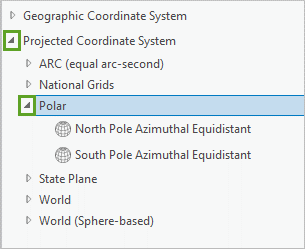
Tip:
Drag the edges of the Map Properties window to brand it larger.
At that place are only two projected coordinate systems, one for the n pole and one for the south pole.
- Click North Pole Azimuthal Equidistant and click OK.
This projection distorts both angles and areas. Baloney is extreme in the southern hemisphere.
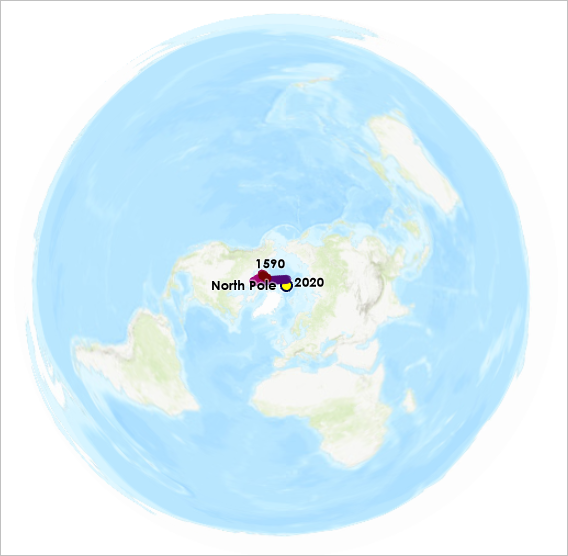
However, this projection is useful for mapping the area around the n pole. It preserves truthful distances and directions measured from the pole.
- In the Contents pane, right-click HistoricalMagneticPoleTrack and choose Zoom To Layer.
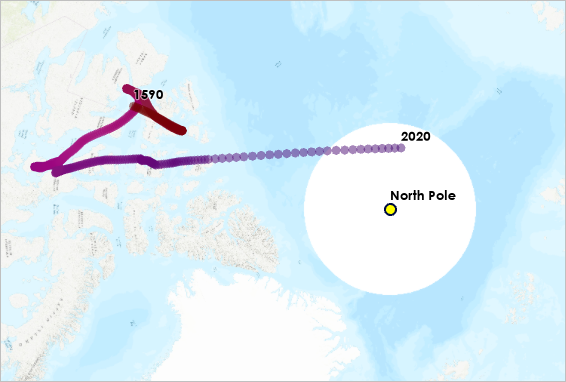
There are some problems with the Topographic basemap. This basemap was designed for the Web Mercator projection, then information technology becomes squished and stretched when information technology is reprojected onto the Azimuthal Equidistant map. Additionally, Web Mercator is unable to prove the poles, so the basemap is cut off by 85° latitude, leaving a bare pigsty in your map.
The Topographic basemap is not suitable for your polar map, then y'all'll find 1 that is.
- In the Contents pane, right-click Topographic and cull Remove.
- In the Catalog pane, click the Portal tab and click the Living Atlas tab.
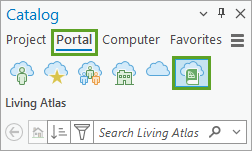
- In the Search bar, type Polar Basemap and press Enter.
- From the search results, right-click Arctic Sea Base and choose Add To Electric current Map.
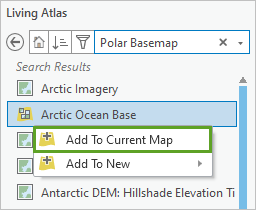
The map updates to display the new basemap, which covers the portion of the globe northward of 50° latitude.
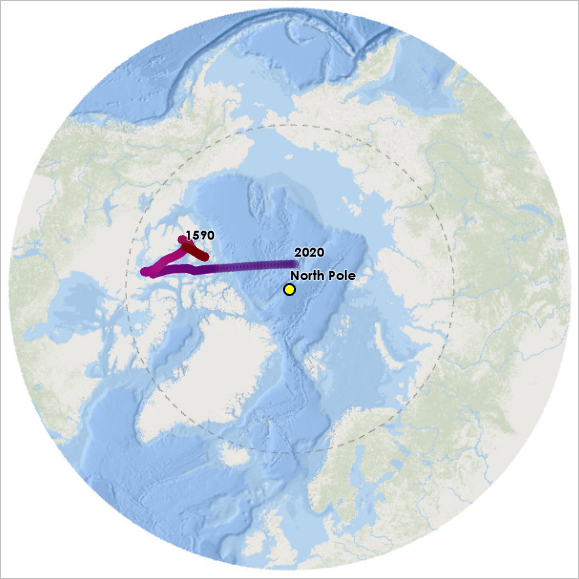
Observe the northernmost magnetic pole
Adjacent, you'll use your map to mensurate distances between true north and the wandering magnetic north pole, to determine the yr when they were closest.
- On the toolbar beneath the map, make sure the Snapping button is highlighted.

Snapping volition allow yous to measure features more easily.
- On the ribbon, click the Map tab. In the Inquiry group, click Measure.
The Measure out Distance window appears on top of the map.
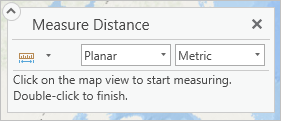
- Click the indicate labeled Due north Pole, and click the point labeled 2020.
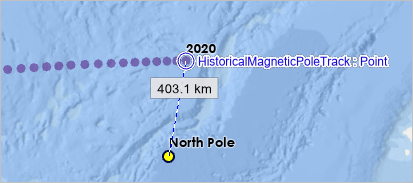
Tip:
Hold the C cardinal or the heart button of your mouse to pan on the map without deactivating the measure out tool.
The tool reports a distance of 403.1 kilometers (250.47 miles).
- On your keyboard, press Esc to clear the measurement.
- Measure the distance between the true north pole and some previous locations of the magnetic north pole.
Magnetic north was nearest to true north in 2022, when it was 394.16 kilometers (244.92 miles) away. Information technology is now heading south, toward Russia.
You can make true distance measurements on this map considering it uses an equidistant project. However, no projection tin preserve all distances. The azimuthal equidistant projection preserves distance and direction from the key point but. So measurements from the north pole are truthful, but measurements betwixt whatever other locations on this map will be inaccurate.
Mensurate geodesic and planar distances
The measurements you've fabricated so far have been planar. Planar distances are similar measuring with a ruler on a paper map. Geodesic distances are like measuring with a cord over the surface of a world. Next, y'all'll compare planar and geodesic measurements between the magnetic north poles of 1590 and 2022.
- Press Esc to clear your current measurement.
- Measure between the signal labeled 1590 and the signal labeled 2020.

The altitude reported between these ii locations is 1,758.73 kilometers (1,092.82 miles). However, the only accurate planar distances that can be made on this map are from the center point. To detect authentic distances between other locations, you lot need to make geodesic measurements.
- Press Esc. In the Measure Distance window, click the Mode menu and cull Geodesic.
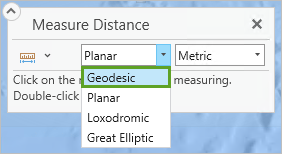
- Measure the altitude betwixt the poles of 1590 and 2022 again.
This time, the reported distance is 1,866.63 kilometers (ane,159.87 miles). The geodesic distance is over 100 kilometers longer than the planar distance.
- Shut the Measure Distance window.
Geodesic distances ignore the map's project and provide a true distance. Planar distances are only true if the map uses a distance-preserving projection, and only to certain points or along certain lines.
The projected coordinate system you chose for this map was already centered on the north pole, which happened to be the location from which yous wanted to measure. But what if you wanted to measure from a different point?
Modify a projected coordinate system
Adjacent, you'll modify the existing coordinate organisation to heart it on the 1590 magnetic northward pole, so measurements can instead be fabricated from that point.
- Zoom to the signal labeled 1590 and click information technology.
The Longitude and Breadth are listed in the pop-up. The coordinates of the pointer can likewise be read in the toolbar below the map.
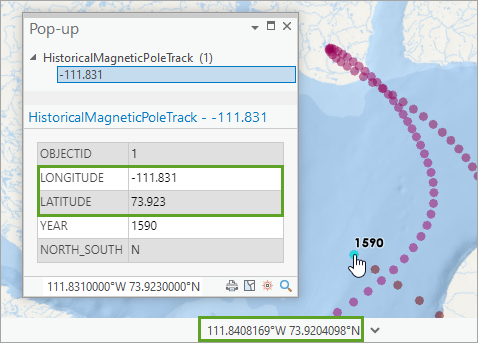
- Close the pop-up.
- Open the Map Properties window and click the Coordinate Systems tab.
- In the XY Coordinate Systems Bachelor list, the electric current coordinate system should be highlighted.
If North Pole Azimuthal Equidistant is not highlighted, use the Search bar to find it.
- Right-click Northward Pole Azimuthal Equidistant. Choose Copy and Modify.
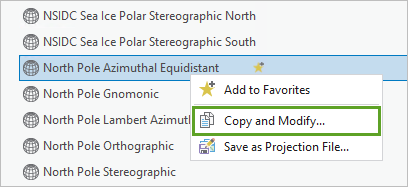
The Change Projected Coordinate Arrangement window appears. Hither, yous can construct a custom coordinate system with parameters that match your needs.
- For Proper noun, type 1590 Magnetic North Pole Equidistant.
The Projection is already set up to Azimuthal Equidistant. A project and a projected coordinate organisation are not the aforementioned affair. A project is i parameter in a projected coordinate system. Other parameters include a geographic coordinate system, a linear unit, and a set of parameters that depend on the selected projection (fundamental meridian, calibration factor, and so on).
You'll adjust the parameters for this projected coordinate organization to middle information technology on the chosen location, instead of true north.
- For Central Meridian, type -111.831. For Latitude Of Origin, type 73.923.
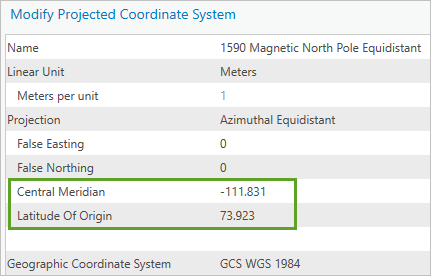
These are the values you observed in the popular-up.
- Click Salvage.
1590 Magnetic North Pole Equidistant is now set equally the Current XY coordinate system for your map. It is also listed in the Custom category of available coordinate systems.
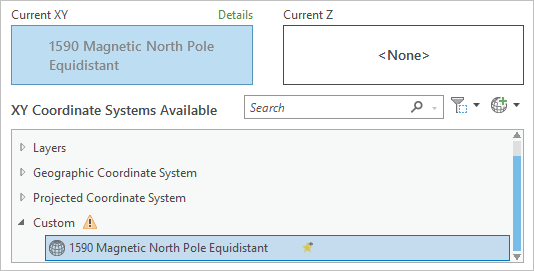
Coordinate systems in the Custom category are not saved. Next, you'll add it to a favorites folder so yous can use it in time to come maps.
- Correct-click the new custom coordinate system and choose Add to Favorites.
- Under Custom, right-click 1590 Magnetic North Pole Equidistant and choose Add to Favorites.
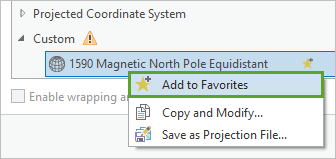
- Scroll to the superlative of the coordinate systems list and expand the Favorites group to ensure that 1590 Magnetic Due north Pole Equidistant is listed there.
Favorite coordinate systems are stored as .prj files in C:\Users\<your user proper name>\AppData\Local\ESRI\ArcGISPro\Favorites.
- In the Map Properties window, click OK to commit the change.
The map redraws with the new projected coordinate system. It looks similar to before, but the center of the map (if non the basemap) has shifted. Both geodesic and planar measurements from the new point volition now be accurate.
- On the Quick Admission Toolbar, click Undo to return the map to the projected coordinate system that is centered on true north.
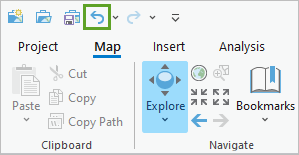
- Relieve the project.
In ArcGIS, you lot can choose betwixt planar or geodesic measurements. But your map reader will not have this choice; they will only see a flat map on a screen or piece of paper. An equidistant projection is the right choice for this map to allow everyone to assess distance correctly from the north pole.
Sometimes, you won't find a projected coordinate organisation that is set-made for your map'due south purpose. ArcGIS Pro allows you to alter any coordinate system to have parameters that better adapt your needs. Adjacent, y'all'll learn how to create a custom projected coordinate organisation using suggested parameters from ArcGIS Pro.
Map the border of two UTM zones
Universal Transverse Mercator (UTM) is a system that is commonly used for large-scale maps. If your map is narrower than 6° of longitude, you lot can map it with a UTM projected coordinate system. The map y'all'll make next is narrow enough simply doesn't fit properly into an existing UTM zone.
In this lesson module, you'll larn how to find the correct UTM projected coordinate system for an area of interest, and how to create a custom projected coordinate system to apply when a standard UTM zone doesn't fit.
Observe the correct UTM zone
You want to map the border betwixt Finland and Russia. This will be a reference map, meant to requite descriptive context to the border region. You desire to use a conformal project to bear witness the shapes of features in their most recognizable forms.
- At the pinnacle of the map view, click the Border tab to actuate that map.
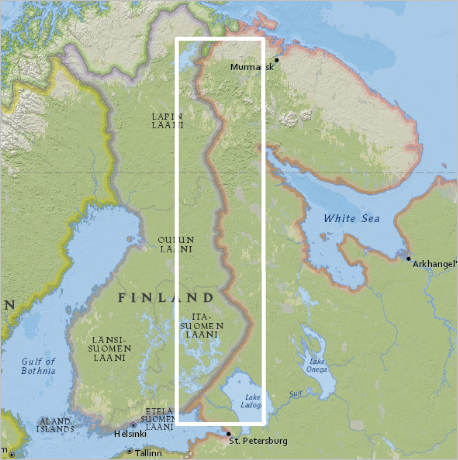
This map currently uses the Web Mercator projection. While the Mercator projection is conformal, Web Mercator (Mercator Auxiliary Sphere) is non. In add-on, this projection distorts expanse and distances dramatically in higher latitudes.
The white rectangle represents the surface area you want to map. Because this is a narrow slice of the globe—inside 6° of longitude—you can utilize a UTM zone. UTM projected coordinate systems are conformal and their baloney of other map properties is minimal.
UTM divides the earth into 60 zones. Side by side, you'll employ a spatial filter to decide which UTM zone to use for your map.
- In the Contents pane, double-click Border to open the Map Properties window.
- On the Coordinate Systems tab, next to the search bar, click Spatial Filter and click Prepare spatial filter.

- In the Spatial Filter Extent window, click Map Neatline.
The values under Selected extent update to match the extent of the Map Neatline layer.
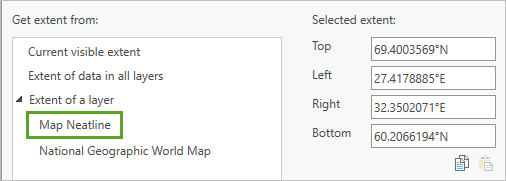
- Click Apply.
The XY Coordinate Systems Available list is filtered to but contain coordinate systems with extents that overlap with your map.
- In the list, aggrandize Projected Coordinate System, UTM, WGS 1984, and Northern Hemisphere.
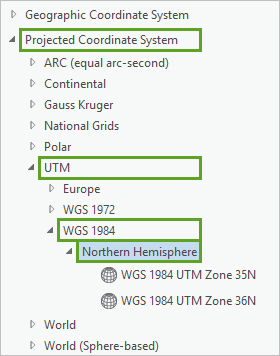
There are two UTM zones for the area that you want to map, 35N and 36N, and you can't tell from this list which zone is best.
- Click Cancel to close the Map Properties window.
Adjacent, yous'll add a layer to your map to visualize the UTM filigree.
- In the Catalog pane, click the Portal tab and click Living Atlas.
- In the search bar, blazon UTM Filigree and press Enter.
- In the search results, correct-click the World UTM Grid feature layer and cull Add To Current Map.
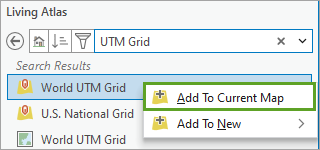
- In the Contents pane, right-click World_UTM_Grid and choose Label.
The Finland-Russian federation border lies on the border of two UTM zones: 35 and 36.
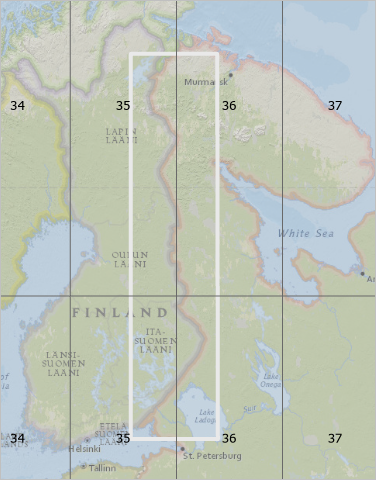
UTM projected coordinate systems minimize distortion to reasonable levels, only only within their zone areas. Neither zone 35 nor 36 will provide this benefit for your map surface area.
- In the Contents pane, right-click World_UTM_Grid and choose Remove.
The World_UTM_Grid layer confirmed that the best option for this map is a custom projected coordinate system. Next, y'all'll create ane for this region.
Create a custom projected coordinate system
ArcGIS Pro can suggest new custom projected coordinate systems based on 2 criteria: baloney property and map extent.
- In the Contents pane, double-click Border to open up the Map Properties window.
- On the Coordinate Systems tab, click the Add Coordinate Organisation button and choose New suggested projected coordinate arrangement.
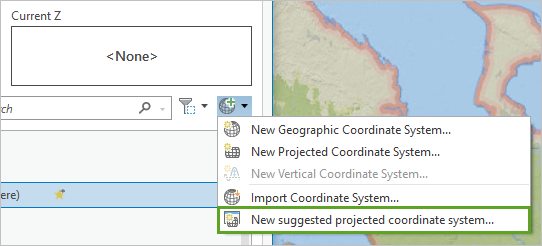
A new window appears.
- For Coordinate System Proper noun, type Republic of finland-Russia Edge. Leave Geographic coordinate organisation set to WGS 1984.

- Under Go extent from, click Map Neatline.
The values under Selected extent update to match the extent of the Map Neatline layer.
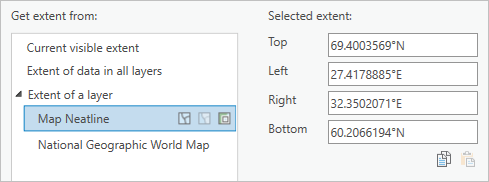
- For Projection property, cull Conformal.
The parameters of the new custom projected coordinate organization appear in the Result box.
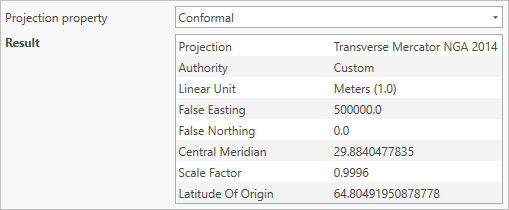
The Projection is set up to Transverse Mercator NGA 2022. This is a variant of the Transverse Mercator project used past UTM zone maps.
Transverse Mercator is a common projection, used by the UTM coordinate systems and some Land Plate coordinate systems. Transverse Mercator NGA 2022 is a variant of this project, with the added reward of being able to evidence a larger portion of the world.
The Central Superlative and Latitude Of Origin parameters are taken from the centre of the Map Neatline rectangle.
The Imitation Easting shifts the origin bespeak of the coordinate organisation far abroad from your map area to ensure that no coordinates have negative values. The Scale Cistron minimizes distortion across the entire 6° zone.
- Click Salve.
- UnderCustom, right-clickRepublic of finland-Russian federation Border and cullAdd together to Favorites.
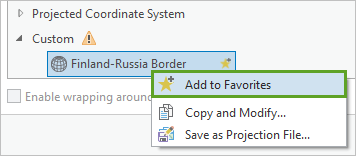
- In theMap Backdrop window, clickOK to commit the change.
The map redraws with the new projected coordinate system.
- In theContents pane, correct-clickNational Geographic World Map and chooseZoom To Layer.
The new projected coordinate system distorts shapes that are far from its cardinal meridian (29.9° E).
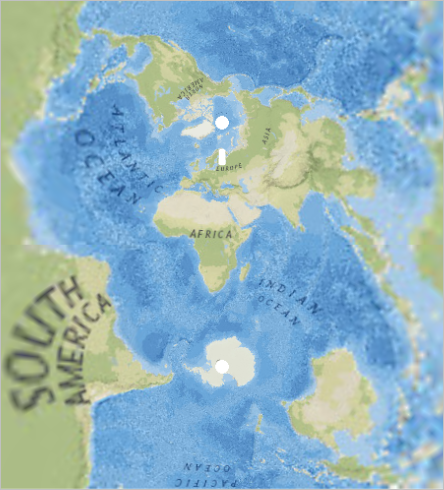
Fifty-fifty though this map can show the entire world, information technology is only appropriate to map areas in the middle of this coordinate system—inside 3° of its primal pinnacle.
- Zoom to the Map Neatline layer.
The image below shows a comparison of the map in the new custom projected coordinate system and in Web Mercator.
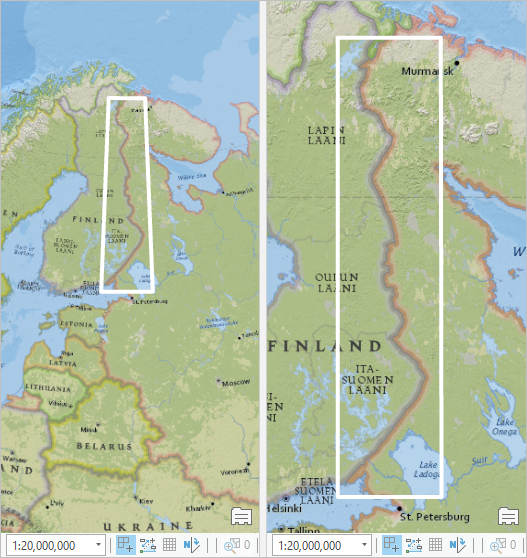
In the custom coordinate system, the shape of the neatline polygon is a trapezoid instead of a rectangle. Its northern border is shorter than its southern edge. The rectangle in Web Mercator is misleading: on the globe, these lines are not the same length. The new project represents them more accurately.
The two maps shown above are drawn at the same scale: ane to 20 1000000. Simply that scale is meaningless in the Spider web Mercator map, since its area distortions are so farthermost. Baloney in the Transverse Mercator map is small enough to exist unnoticeable, and more than precise measurements tin be made on that map.
Before in this lesson, y'all learned how to change coordinate systems. How could you alter an existing UTM coordinate arrangement to center it on the Russia-Finland border? How could you modify the Equal Earth project from the start of this lesson to better show the Pacific Ocean?
Tip:
Copy and modify whatever WGS 1984 UTM Zone coordinate system. Alter the central meridian to 29.9.
Copy and modify the Equal Earth (world) coordinate organisation. Change the central meridian to 160°West or a similar value.
In this lesson, y'all learned some techniques and explored resources that will aid y'all cull an appropriate map projection:
- Consult the Quick Notes on Map Projections in ArcGIS chart.
- Review the ArcGIS help documentation for supported map projections.
- Perform keyword searches and spatial filters in ArcGIS Pro.
- Copy and modify existing projected coordinate systems in ArcGIS Pro.
- Access the UTM Grid reference layer in ArcGIS Living Atlas of the World.
- Create a custom projected coordinate organisation in ArcGIS Pro with an extent and projection property.
Take a closer await at the maps yous see on the internet, in the news, or in apps. Practise they employ a projection that is well suited to their purpose? Are their distance and area measurements accurate?
The consequences of ignoring your choice of map projection include distorting your data and misleading your map readers. Nevertheless, if you spend some time to notice an appropriate projected coordinate organisation, you'll create a map that presents your data and your message clearly and accurately.
You tin find more lessons in the Learn ArcGIS Lesson Gallery.
Send Us Feedback
Please ship the states your feedback regarding this lesson. Tell u.s. what you liked as well as what you didn't. If something in the lesson didn't work, let the states know what information technology was and where in the lesson you encountered it (the section name and footstep number). Employ this course to send us feedback.
Source: https://learn.arcgis.com/en/projects/choose-the-right-projection/
Posted by: mcgrathextured.blogspot.com


0 Response to "How To Correct A Drawings Coordinate System In Maps 3d"
Post a Comment